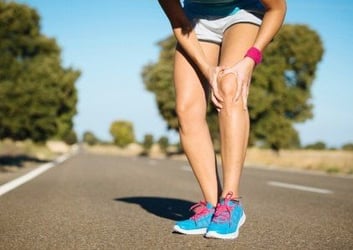Whether you’ve just started a couch-to-5K running program or you’re a seasoned marathoner, you’re probably no stranger to aches and pains in your legs and knees as you grow muscle and improve your stamina. But how do you know if the pain is normal or part of a bigger issue? Ahat does it mean if you have pain behind your knee when you run?
Watch this video from Greenville health coach Aaron Benator and read on to find out.
Understanding Pain Behind the Knee
More often than not, pain behind the knee is diagnosed as patellofemoral pain syndrome (PFPS). Patello is the patella, so the kneecap. Femoral refers to the femur, which is the thighbone and pain and syndrome is PFPS, patella femoral pain syndrome. It usually happens to runners and cyclists and hikers.
However, people who sit for most of the day in sedentary jobs or sedentary lifestyles, it can also happen to them. There are a couple of muscles involved with this. The quadriceps muscle is the big muscle at the front of the thigh. The calves are the sizable muscles behind the shin, and the hamstrings are the muscles behind the thigh.
So these control the joints of the lower body.
PFPS can be caused by overuse (such as recent changes in your exercise routine), biomechanical abnormalities (such as a high arch or flat foot) or muscle dysfunction (such as weak quadriceps, tight hamstrings or tight calves).
PFPS typically feels like mild or severe discomfort that radiates from the back of the knee cap touching the thigh bone.
Is Pain Behind the Knee Normal?
 Pain behind the knee, or anterior knee pain, is a very common complaint with high impact exercises like running. But just because it’s common doesn’t mean it should be ignored or left untreated. If you experience swelling, clicking, popping, locking or giving-way of the knee, it’s important to see your physician to rule out ligament or soft tissue damage.
Pain behind the knee, or anterior knee pain, is a very common complaint with high impact exercises like running. But just because it’s common doesn’t mean it should be ignored or left untreated. If you experience swelling, clicking, popping, locking or giving-way of the knee, it’s important to see your physician to rule out ligament or soft tissue damage.
When you first notice pain behind the knee, it will be particularly helpful to track your exercise regimen with a fitness app to identify periods of intense exercise and how your activity level varies. You’ll also want to make note of the intensity of the pain on a scale of 1-10, where the pain occurs, whether it occurs at different times of the day (which could indicate arthritis) and whether it diminishes over time. Tracking all of this information will inform your physician on details that can be helpful in your diagnosis and treatment plan.
Strengthen Your Knees to Avoid or Lessen Pain
If you’re experiencing pain behind your knees while running, it doesn’t mean you’re destined to stop exercising. There are many simple things you can do every day to reduce or completely avoid the pain. Here are six strategies to start with:
- Add RICE to your routine. RICE — or Rest, Ice, Compress and Elevate — helps decrease inflammation swelling to give your knee a chance to heal. This is especially helpful if the pain is a result of aggravation or soft tissue problems.
- Strengthen your quadriceps. Sometimes knee pain comes from weakened muscles above or below the knee. A certified health coach or physical therapist can prescribe quadricep strengthening exercises, such as straight leg raises, which will help you tone the muscles that connect to your knee.
- Stretch your legs. If you’ve just begun a running routine, basic leg stretches are especially helpful to prevent or decrease pain.
- Use tape or a brace. Athletic taping and bracing can stabilize your knee and protect it from further damage.
- Buy the right footwear. Proper footwear and insoles will ensure that your shoes actually meet the needs of your heel, arch and knee. Many specialty shoe stores can do a free gait analysis - an assessment of the way we walk or run that identifies any biomechanical abnormalities. With the results of your gait analysis and your movement patterns, the shoe store can recommend the best products.
- Modify your exercise. More often than not, it’s dangerous to push through pain. As you heal from whatever is causing the pain in your knee, consider modifying the frequency, intensity, time and type of exercise you perform.
Knee pain can be an uncomfortable and disheartening effect of an exercise routine. However, working with a certified health coach or your physician can help you identify the source of pain before it becomes a bigger issue and take the right steps to ease or avoid the pain in the future.
Access Wellness University & Certified Health Coaches
PartnerMD memberships include access to our members-only wellness program, Wellness University, which delivers more than 70 physician-approved courses and certified health coaching targeting the 4 areas most critical to your health, including stress and sleep, brain health, nutrition, and strength and mobility.
With offices in Richmond, VA; Midlothian, VA; Short Pump, VA; McLean, VA; Baltimore, MD; Greenville, SC; and Atlanta, GA, you can experience primary care built around you, one focused on wellness and prevention to help you stay as healthy as possible, as long as possible. Learn more about health coaching at PartnerMD.
Aaron Benator, Certified Health Coach
As a certified health coach at PartnerMD in Greenville, SC, Aaron provides personalized coaching tailored to your needs. He focuses on nutrition, exercise, and mental well-being. Aaron emphasizes a balanced lifestyle and is dedicated to helping you achieve your wellness goals.